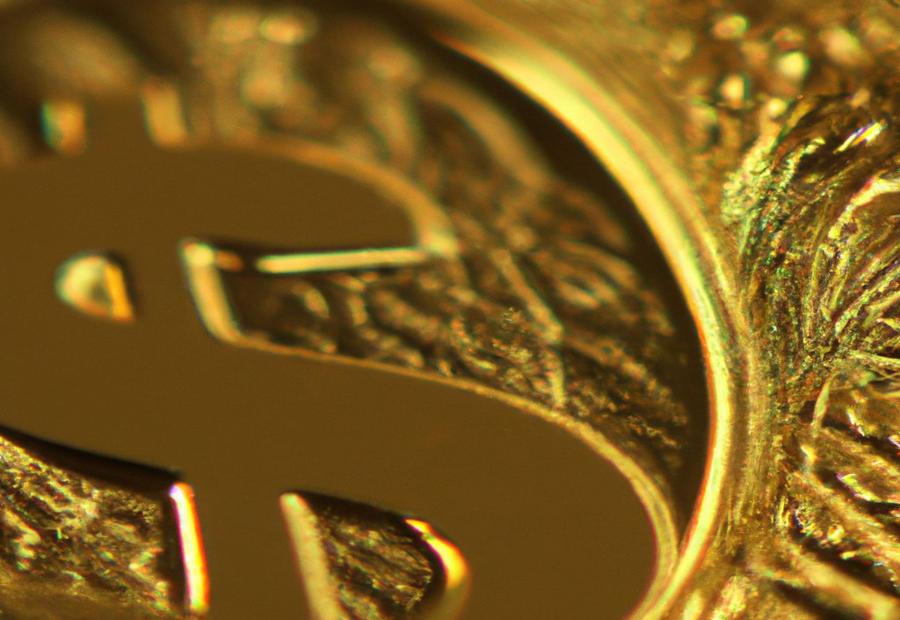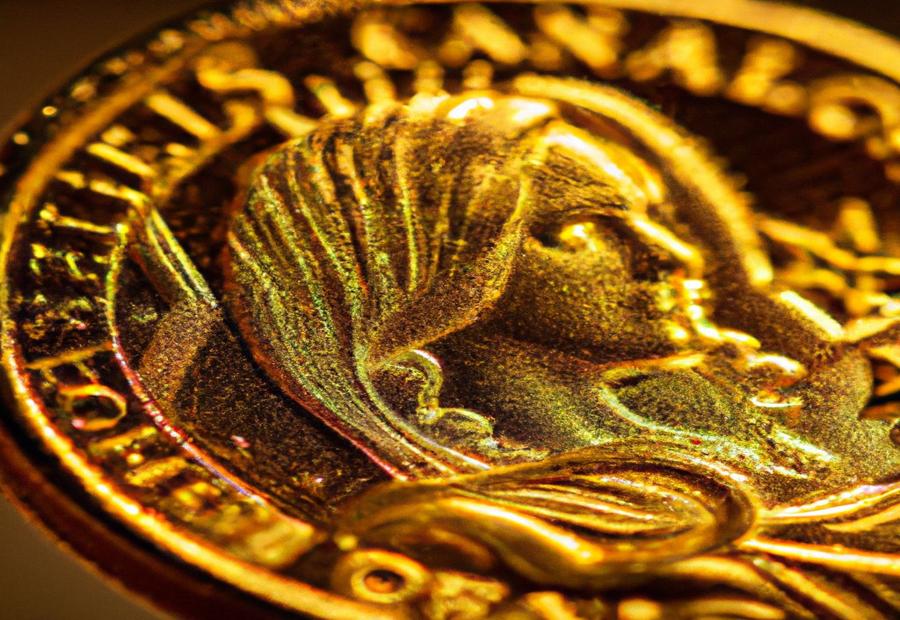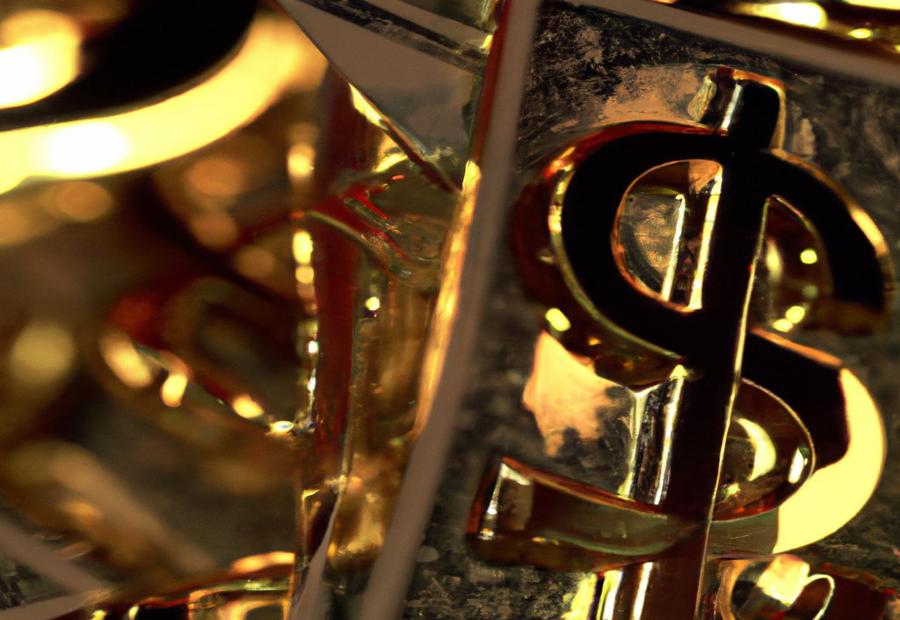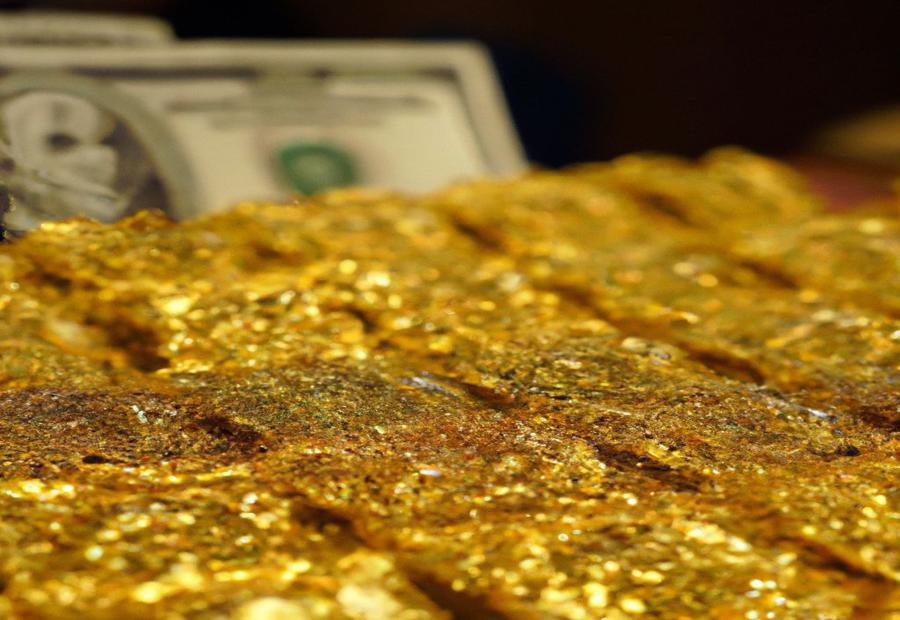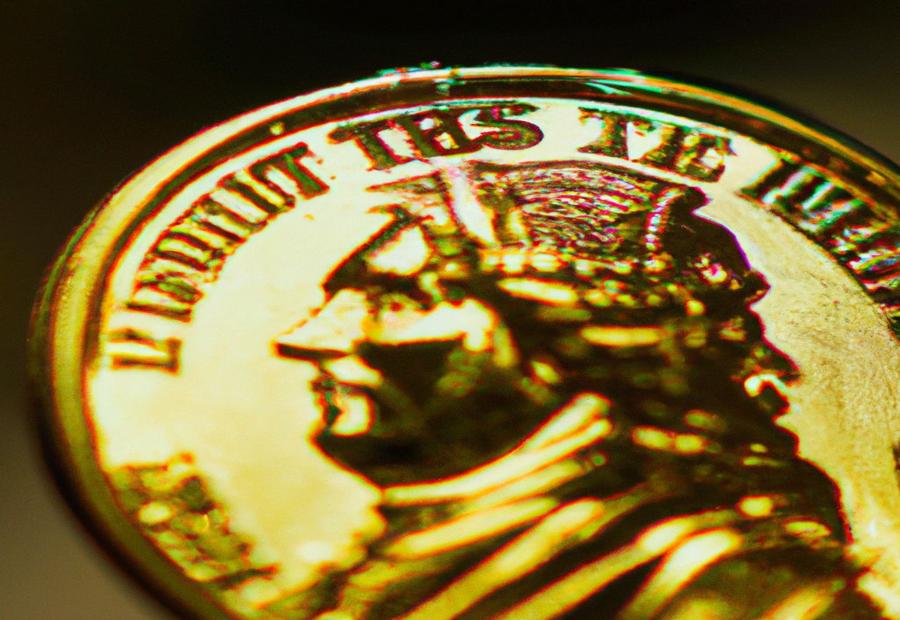Key Takeaway:
- Gold Dollars have played an important role in the US monetary system, with a rich historical background.
- Modern Gold Dollars are composed of specific materials, including Manganese Brass Alloy and a Copper Core, to ensure durability and production efficiency.
- The value of Modern Gold Dollars can vary based on multiple factors, such as numismatic guides and charts, and they are collected by enthusiasts as a hobby.
Introduction
Photo Credits: Ecopolitology.Org by Robert Sanchez
Gold dollars hold an intriguing place in the history of the US monetary system, with a rich background and long-lasting significance. In this section, we will delve into the importance of gold dollars in the US monetary system, as well as explore the historical events that shaped their role. Prepare to uncover fascinating facts and gain insight into the historical context surrounding gold dollars.
Importance of Gold Dollars in the US monetary system
Gold Dollars in the US monetary system are immensely important. They’ve been essential for stability and a huge part of the country’s money history. They’re a medium of exchange, store of value, and unit of account – vital to the US economy.
Gold Dollars have a long history, from the beginning of American independence to modern times. They’ve changed design, composition, and circulation – keeping up with technology.
They have unique properties that make them ideal for transactions: manganese brass alloy and copper core are durable and resistant to wear.
Modern Gold Dollars have multiple uses – they represent wealth and help people make transactions easily. They’re distributed around the economy to meet demand for currency.
Their value depends on various factors – metal worth, market demand, rarity, condition, and collector interest. Numismatic guides and charts help to judge these factors and find the true value.
Collecting Gold Dollars is popular among hobbyists and investors. They love their history, designs, and investment potential. But it can be challenging, too – tracking down rare variants and avoiding counterfeiters. Forums, auctions, and numismatic publications help coin enthusiasts pursue their hobby.
Gold Dollars have been around for centuries and still shine bright today.
Historical background of Gold Dollars
Gold Dollars are steeped in history for the US monetary system. They popped up as currency in the early 19th century and had a big effect on the economy back then. Different types and denominations of Gold Dollars were minted, each with its own unique features. Modern Gold Dollars are made from a Manganese Brass Alloy and a Copper Core, giving them strength and steadiness.
The goal behind creating modern Gold Dollars was to guarantee a steady currency supply and help out with economic transactions. However, ensuring an adequate supply of these coins has been tricky. The value of Gold Dollars is based on factors like metal content, rarity, and demand in the market. Collecting Gold Dollars is a popular hobby for numismatists, who appreciate their historical importance and gorgeousness.
What are Gold Dollars?
Photo Credits: Ecopolitology.Org by Gary Martinez
Gold dollars have always intrigued both investors and collectors alike. In this section, we will delve into the world of gold dollars, exploring their definition, characteristics, and the different types that exist. Prepare to uncover the fascinating history and allure of these golden treasures.
Definition and characteristics of Gold Dollars
Gold Dollars are an integral part of the US monetary system. They have a historic significance and unique qualities that make them different from other forms of currency. To comprehend Gold Dollars, one must explore their composition, purpose, and value in the economy.
Gold Dollars are made from specific materials such as manganese brass alloy and copper core. These materials give them longevity and an attractive appearance. They also determine the weight and size of Gold Dollars.
Gold Dollars are created for a particular reason: to serve as a medium of exchange and to facilitate transactions. However, certain issues, such as demand variations or production limitations, could affect the supply of these coins.
The value of Gold Dollars depends on several factors, including their composition, rarity, and historical significance. Numismatic guides and charts can help understand the value of these coins based on market trends and collector’s preferences. Collecting Gold Dollars can be a fun pastime and a potential investment.
For many years, the San Francisco mint has been producing Gold Dollars. The Government Accountability Office has also conducted a report on Gold Dollar circulation and worth. This research sheds light on the importance and value of Gold Dollars today.
Different types of Gold Dollars
Gold Dollars come in numerous types. They have distinguishing characteristics and historical importance. One can classify the many types of Gold Dollars by design, denomination, and issuing authority.
Check out the summary in the table below for some popular Gold Dollar types:
| Type | Design | Denomination | Issuing Authority |
|---|---|---|---|
| Type I | Liberty head facing left | $1 | US Mint |
| Type II | Liberty head facing right with small crown | $1 | US Mint |
| Type III | Indian princess wearing feathered headdress | $1, $3, $5 | US Mint |
Collectors should note that these are just a few examples. Each type has its own design and worth in the numismatic world.
There are rare and valuable Gold Dollar varieties that are highly coveted by coin hobbyists. Such as proof versions, commemorative coins, and coins minted at certain locations like San Francisco or New Orleans.
Collecting Gold Dollars offers an amazing look into the historical and cultural legacy of our nation’s money. Whether one is attracted to the intricate designs or the value of these coins, collecting Gold Dollars promises an exciting and informative pastime.
Composition of Modern Gold Dollars
Photo Credits: Ecopolitology.Org by Mark Ramirez
Modern Gold Dollars are not pure gold; they are a combination of materials carefully chosen to create a durable and valuable currency. In this section, we will explore the composition of Modern Gold Dollars, focusing on the explanation of the materials used and the role of the Manganese Brass Alloy and Copper Core in their production. Get ready to uncover the fascinating blend that makes up the gold dollars we use today.
Explanation of the materials used in Modern Gold Dollars
Modern Gold Dollars are made from special materials that give them their distinct features and value. Manganese brass alloy and a copper core are used in the composition of these coins. These materials are essential to ensure the coin’s durability and integrity.
Manganese brass alloy is tough and resilient. It resists wear and corrosion and maintains the coin’s aesthetics. The copper core adds to the weight and structure; providing balance and feel.
These materials are chosen carefully to meet regulatory standards. This makes sure each coin meets the necessary specifications to be legal tender and keeps the coin’s inherent value.
Manganese brass alloy and copper core provide resistance to tarnishing and durability for long-term use. So, Modern Gold Dollars keep their value over time and serve as a dependable form of currency.
Throughout history, different compositions were used for gold dollars depending on the technology at the time. However, modern coins use these materials due to their superior qualities.
Role of Manganese Brass Alloy and Copper Core in the production of Gold Dollars
Manganese Brass Alloy and Copper Core are a unique combo used in the production of Gold Dollars. This specific blend is crucial to the coins’ characteristics and production process.
Manganese Brass Alloy is key as it provides strength and durability. This is especially important because Gold Dollars circulate frequently. Plus, it gives the coins a distinct golden hue.
Copper Core is also necessary. It has antimicrobial properties, helping to prevent the spread of germs. It also enhances conductivity and contributes to the coin’s weight and feel.
The roles of Manganese Brass Alloy and Copper Core in creating Gold Dollars are vital. They contribute to the coins’ physical attributes and durability, as well as public health standards.
Collectors should take note of material composition variations when assessing Gold Dollar value. They may affect rarity and desirability.
Intention and Circulation of Modern Gold Dollars
Photo Credits: Ecopolitology.Org by Nicholas Thomas
The intention and circulation of modern gold dollars, along with their purpose, distribution, and challenges in maintaining an adequate supply – let’s dive into these aspects to unravel the fascinating world of gold currency and its significance in our economy.
Purpose and objectives behind the creation of Modern Gold Dollars
Gold Dollars were created to serve a purpose. They were a form of currency backed by gold, which helped the US economy stay stable. Modern Gold Dollars have special materials, like manganese brass alloy and copper core, that keep them durable and genuine.
Their creation had multiple objectives. One was to provide a reliable currency that held its value. Gold Dollars also had to be in plentiful supply, but not too plentiful.
Getting Gold Dollars into circulation is complicated. Challenges may come up, such as changes in demand or production issues. Efforts are made to make sure there are enough of them.
What a Gold Dollar is worth depends on many things, such as the gold content, the market, and the economy. Numismatic guides help people figure out how much individual pieces are worth.
Collecting Gold Dollars is a hobby for many. They appreciate the historical significance and beauty. It can be difficult to know if the coins are real or fake.
Distribution and circulation of Modern Gold Dollars in the economy
Modern Gold Dollars play a significant role in the monetary system of the United States. They are made of durable materials such as Manganese Brass Alloy and Copper Core, which makes them suitable for circulation.
Gold Dollars are issued by the government and distributed through banks and credit unions. Collectors also sell them.
Maintaining an adequate supply is a challenge. Demand changes and authorities must manage production and distribution carefully.
To address this, forecasting techniques can be used to anticipate usage. Analyzing data on usage patterns and economic indicators is helpful.
Encouraging electronic transactions can reduce reliance on physical cash. This can help with supplying enough Gold Dollars.
Challenges in maintaining adequate supply of Gold Dollars
Gold Dollars face challenges in keeping an adequate supply. One main issue is high demand for them as currency. Supply is limited, making it hard to meet the demand. Producing and minting Gold Dollars needs careful management. Necessary materials, such as manganese brass alloy and copper core, also have an impact.
The unique nature of Gold Dollars causes more issues. Both collectors and currency users want them. When gold’s value rises, people are less likely to spend or circulate their Gold Dollars, reducing their supply.
Logistical considerations affect the availability of Gold Dollars too. Minting facilities must be well-equipped and staffed. Transporting and storing the coins also requires careful planning. Issues with these processes can hinder Gold Dollar circulation.
To maintain a sufficient supply of Gold Dollars, stakeholders need to monitor factors like demand, competition from collectors, gold value fluctuations, and the availability of materials. Strategies must be adapted accordingly.
Value of Modern Gold Dollars
Photo Credits: Ecopolitology.Org by Gary Martinez
When it comes to the value of modern gold dollars, understanding the factors that determine their worth is crucial. In this section, we will explore how to determine the value of these gold dollars, the various factors that influence their worth, and the role of numismatic guides and charts in assessing their value. Get ready to delve into the world of gold dollar valuation and gain insights into this fascinating realm of currency.
Determining the value of Modern Gold Dollars
Let us examine the different aspects that can influence the value of modern gold dollars by looking at an informative table.
Table: Factors Influencing the Value of Modern Gold Dollars
| Factors | Details |
|---|---|
| Composition | Manganese Brass Alloy and Copper Core. These elements contribute to durability and appeal. |
| Rarity | Scarcity or limited availability increases desirability. Historical background and specific mint marks also matter. |
| Condition | Overall condition affects the value. Minimal damage, wear, or scratches are more valuable. |
| Numismatic Guides | Numismatic guides and charts provide pricing trends, historical data, and market demand. These resources help determine value accurately. |
It is essential to note: More unique details may exist.
By considering these factors, collectors and enthusiasts can make informed decisions. However, it is crucial to consult reliable numismatic guides and explore resources to stay updated with changing market dynamics.
Factors influencing the value of gold dollars: Logical and irrational things can determine their worth.
Factors influencing the value of Gold Dollars
Various factors influence the value of Gold Dollars. These include the materials used, market conditions, economic stability, and geopolitical events.
Manganese Brass Alloy and a Copper Core make up modern Gold Dollars. This ensures their durability and distinct golden hue.
Supply and demand dynamics influence the price of Gold Dollars. If demand is high, their value rises. If demand decreases, or there’s an oversupply, their value falls.
Economic stability is also key. Investors often turn to gold during economic uncertainty or inflation – driving up its value.
Geopolitical events can have major impacts too. Political tensions and global financial crises cause investors to seek refuge in gold, increasing its value. Conversely, stable political environments and strong currencies may reduce investor interest, resulting in lower values.
Numismatic guides and charts help collectors avoid expensive mistakes. They can use them to make informed decisions regarding their investments in gold.
Role of numismatic guides and charts in assessing the value of Gold Dollars
Numismatic guides and charts are key to assessing Gold Dollar value. They provide info on historical significance, minting variations and condition. They are a great resource for collectors, investors and enthusiasts who want to determine their Gold Dollar worth. By referencing numismatic charts, individuals can compare market prices, track trends and make informed decisions to buy or sell.
The guides also often include details on overall grade. Wear and tear, scratches, toning and other imperfections can greatly impact the coin’s value. These guides help collectors accurately assess their dollar grade.
Charts are especially helpful for rare or limited edition Gold Dollars. They track auction results, sale prices from dealerships and other data to create an overall market value picture. Collectors can make more educated decisions when buying and selling.
Numismatic guides and charts are essential when collecting or investing in Gold Dollars. Staying up-to-date on trends will ensure collectors are informed about the value and rarity of coins. Use these resources to maximize returns and enjoy the historical significance of each Gold Dollar.
Unlock the hidden value of your Gold Dollars! Gain insights into historical significance and market worth. Stay informed, make well-informed decisions and maximize potential returns on investments. Collecting Gold Dollars as a Hobby: Pockets to treasure chests with a touch of historic bling!
Collecting Gold Dollars as a Hobby
Photo Credits: Ecopolitology.Org by Ronald Taylor
Collecting Gold Dollars as a hobby offers intriguing insights into rare and valuable pieces of currency. From an overview of this fascinating hobby to the benefits and challenges collectors encounter, this section provides valuable resources for enthusiasts. Dive into the world of Gold Dollar collection and uncover the hidden treasures and stories behind these unique pieces of history.
Overview of collecting Gold Dollars as a hobby
Collecting Gold Dollars has become a popular hobby, especially for numismatists and coin enthusiasts. People are drawn to the history and unique features of these coins. Gold Dollars have a special place in the US monetary system because of their rich background, adding to their value.
Gold Dollars are not ordinary coins. They are composed of Manganese Brass Alloy and Copper Core, making them strong and distinct. This mix of materials keeps them valuable and sought-after by collectors.
One part of collecting Gold Dollars is to find out their value. Many aspects decide it, such as condition, rarity, and history. Numismatic guides and charts help in assessing the value of these coins.
Collecting Gold Dollars also brings challenges. It is hard to find rare or valuable coins due to limited supply. Additionally, proper storage and handling are needed to preserve their condition.
Overall, collecting Gold Dollars is an interesting look into US monetary history while providing an engaging hobby. Whether for historical preservation or investment, these coins hold great value for those who appreciate them.
Benefits and challenges of collecting Gold Dollars
Collecting Gold Dollars can be both beneficial and tricky. Firstly, the historical significance of these coins adds value to the collection. Appreciating the artistry and craftsmanship on these coins makes them captivating pieces.
Collecting Gold Dollars can offer a financial gain as gold prices change. Plus, collecting these coins can make you feel proud and accomplished.
However, there are some challenges. It’s hard to find authentic and high-quality coins. Also, finding different types of Gold Dollars with different designs and mint marks is difficult.
To maximize the experience of collecting Gold Dollars, resources like numismatic guides and charts can help. These resources can be used by both beginners and experienced collectors to determine fair prices.
Pro Tip: When starting your collection, ask experienced collectors for advice or join numismatic societies for guidance on the market and building a valuable assortment of Gold Dollars.
Resources for collectors
Gold Dollar collectors have a range of tools to boost their pastime and learning. These include:
- online marketplaces to buy, sell and browse coins from sellers around the world
- forums and communities to connect with fellow enthusiasts
- professional grading services to authenticate and evaluate coin condition
- numismatic museums to view rare Gold Dollars up-close
Using these resources, collectors can gain more knowledge, stay informed, meet other hobbyists, and expand their collections.
However, collecting Gold Dollars has its tricky bits. Certain coins can be scarce or pricey. Plus, counterfeit coins could be an issue. But the joys of having a unique collection make Gold Dollar collecting a fun hobby for numismatic fanatics.
In fact, collecting Gold Dollars can be more enjoyable than just watching your favorite TV shows!
Conclusion
Photo Credits: Ecopolitology.Org by Mason Carter
In the conclusion, we will summarize the significance and value of Gold Dollars today, explore the role of the San Francisco mint in their production, and gain insights from the Government Accountability Office report on Gold Dollar circulation and value.
Summary of the importance and value of Gold Dollars in the present day
Gold dollars are highly prized in today’s economy due to their history, makeup, and collectibility. The San Francisco mint plays the most important role in producing these coins. The Government Accountability Office report reveals issues relating to the circulation and worth of gold dollars. By knowing the elements that drive their value, collectors can wisely add them to their collections. The San Francisco mint shines by creating gold dollars. Even in the foggy city, there’s always a gleaming side!
Examination of the role of San Francisco mint in Gold Dollar production
The San Francisco Mint has a long history of making Gold Dollars. It employs modern methods and traditional craftsmanship to create coins that meet government standards. The mint also distributes the coins throughout the US economy.
Gold Dollars are composed of a manganese brass alloy outer ring and a copper core. These materials help maintain the coins’ value and quality.
The San Francisco mint faces the challenge of providing enough Gold Dollars to meet fluctuating demand. To do this, the mint must plan, allocate resources, and collaborate with other mints.
In conclusion, the San Francisco mint is essential for Gold Dollar production. It keeps the coins valuable and important in today’s economy.
Insights from the Government Accountability Office report on Gold Dollar circulation and value
The Government Accountability Office report offers insights into Gold Dollar circulation and value. It examines distribution channels, supply and demand, economic indicators, and market conditions which affect the value of these coins. A unique detail is the role of government policies and regulations in sustaining and stabilizing the value of Gold Dollars.
Individuals interested in investing or collecting Gold Dollars can benefit from this report. By analyzing the findings, they can make informed decisions. Knowing trends is key, as currency values and economic uncertainties are ever-changing. By being proactive and utilizing the insights from this report, individuals can make sure they don’t miss potential opportunities.
Some Facts About “How Much Gold Is in $1?”:
- ✅ Gold dollars minted from 1849 to 1889 contained actual gold. (Source: Team Research)
- ✅ Modern “gold dollars” minted since 2000 no longer contain precious metal gold. (Source: Team Research)
- ✅ The present-day “gold dollars” are made with a copper core and an outer layer of manganese brass alloy. (Source: Team Research)
- ✅ The primary purpose of modern gold dollars was to circulate widely and save money, but it has not been successful. (Source: Team Research)
- ✅ The majority of modern gold dollars are worth one dollar, with some exceptions for rare varieties and certain errors. (Source: Team Research)
FAQs about How Much Gold Is In $1?
How much gold is in a Gold Dollar coin?
Gold Dollar coins minted from 1849 to 1889 actually contained real gold. However, since 2000, modern Gold Dollars are made with a copper core and an outer layer of manganese brass alloy that appears golden in color. These coins do not contain any precious metal gold.
Which U.S. Mints produced Gold Dollars?
U.S. Mints produced Gold Dollars from 1849 to 1889. The present-day Gold Dollar coins, such as Sacagawea Dollars, Presidential Dollars, Native American Dollars, and American Innovation Dollars, are minted by various U.S. Mints, including San Francisco.
What is the value of a modern Gold Dollar coin?
Most modern Gold Dollar coins are worth one dollar due to their large mintages and limited demand. However, there are some exceptions, particularly in the Sacagawea Dollar series, where certain varieties are relatively rare and in demand. The values of these coins can vary, but for the most part, they are worth one dollar.
Are there any valuable exceptions among Sacagawea Dollars?
Yes, there are a few valuable exceptions among Sacagawea Dollars. The 2000-P Sacagawea “Wounded Eagle” variety can sell for prices ranging from $5 to $299. The 2000-P “Cheerios” variety, created as a promotion, can range in value from $8.50 to $500. Additionally, there are “mule” coins, where mismatched dies were used, which can be quite valuable.
What is the value of Presidential Gold Dollars?
The majority of Presidential Gold Dollars are worth one dollar or slightly more. Uncirculated coins can range in price from $1.35 to $6.50, with some error coins having higher value. The highest grade circulation strike coins may have slightly higher value, but generally, only a few listed error coins have significant value.
What is the value of Native American Gold Dollars?
The Native American Gold Dollars, issued from 2009 to date, have a value of $1.00 to a few dollars for high-grade uncirculated specimens. These coins were created for numismatic sales rather than circulation.

.jpg)


